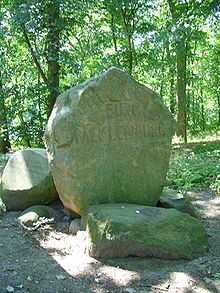- Mecklenburg Castle
-
Mecklenburg Castle was a medieval castle and a residential capital of the Nakonid and Nikloting dynasties of the Obotrites. It was located just south of the modern village Dorf Mecklenburg, seven[1] kilometres south of the Bay of Wismar in Mecklenburg-Vorpommern, Germany. The only remnants of the ruined castle are parts of an earthen wall. Some scholars have associated Mecklenburg with the medieval trading emporium Reric.[2]
Contents
Etymology
The travelling merchant Ibrahim Ibn Jacub described Mecklenburg as “Nakon’s Castle” in 965. By 995 it was documented as Michelenburg[3] or Mikelenburg, meaning large castle in Low German. In Latin, it was known as Magnopolis. The later duchy and region of Mecklenburg derives its name from the castle. The probable Slavic name, Veligrad also (“great” or “large castle”).[3] was commemorated in a new Schloss Weligrad built between 1896 and 1898 for Duke John Albert of Mecklenburg.
History
Excavations indicate that the first castle of Mecklenburg was built in the 7th or 8th century in a lowland at the tip of a lakeland peninsula.[4] It was possibly the Obotrite residence of Reric, destroyed in 808. If associated with Reric, merchants were at the castle by the beginning of the 9th century.[1] Significant market traffic would have developed in the 10th century.; a number of silver artifacts have been found in the vicinity of the ruins.[1]
The castle of Mecklenburg became a seat of Obotrite princes by the 10th century at the latest. It lay on a route from Hamburg to Wolin, assuring the castle importance as an economic and political center. The powerful Obotrite prince resided in the castle by 965.
The castle flourished as the residence of the Christian prince Gottschalk (ruled 1043-1066) and the seat of the Irish bishop John of Mecklenburg; the castle contained churches and three monasteries by 1066. During a widespread pagan rebellion later that year, Gottschalk was killed and his family fled from Mecklenburg Castle. The head of Bishop John was displayed at the pagan center of Rethra.[5]
Henry, a younger son of Gottschalk, avenged his father’s death by killing the pagan usurper Kruto in 1093. However, he chose as his residence Liubice, which was near the borders of the Wagrians, Polabians, and Obotrites, instead of Mecklenburg Castle, which was in the heart of the Obotrite territory. The castle also began to lose its prominence as the Kingdom of Germany began expanding eastward.
As part of Duke Henry the Lion of Saxony’s expansionary goals, the Archbishop of Bremen placed a bishop named Emmehard at Mecklenburg in 1149, as the bishopric had been vacant since 1066.[6] In 1160 King Valdemar the Great of Denmark and Henry the Lion campaigned against the Obotrite prince, Niklot, who burned his castles at Ilow, Mecklenburg, Schwerin, and Dobin in order to avoid being pinned down in sieges. Niklot was ultimately killed at Werle during the campaign, however, and the Obotrite territory was partitioned between Saxon ministeriales; Mecklenburg Castle passed to Count Heinrich von Schaten.[7] The Bishopric of Mecklenburg was replaced by the Bishopric of Schwerin in the same year.
Niklot’s son Pribislav led a Slavic rebellion in 1163 against Henry the Lion and the German lords occupying Obotrite castles. Although Pribislav sacked Mecklenburg in 1164, the rebellion was eventually defeated at the Battle of Verchen later that year. In need of an ally against the Saxon nobility three years later, Henry allowed Pribislav to receive his father’s Niklot’s inheritance and became the Prince of Mecklenburg, Kessin, and Rostock.
Market traffic was documented at Mecklenburg in 1168, although most of the trade was passing to Schwerin.[1] In 1265, the castle was torn down to provide building material for the construction of a palace in the growing city of Wismar. Although the princes in Schwerin rebuilt the castle at Mecklenburg in 1277 for use as a staging point for raids, it was demolished 45 years later.
The modern village of Mecklenburg developed from a mid-14th century settlement near the castle. After the cursory removal of the ruins, the rampart was used for agriculture. Georg Christian Friedrich Lisch, active from 1839-41, was the first to begin surveying the ruins. The wall was established as a memorial in 1854 by Friedrich Franz II, Grand Duke of Mecklenburg-Schwerin, while reforestation with oak trees began two years later. From 1967-71, Prof. Dr. Donat of the Akademie der Wissenschaften der DDR led extensive excavations into a 52 m section of the southern wall and an area of 1,175 m² near the ruins. The diameter of the oval inner court reached 95 to 140 metres, while the ramparts rose 10 metres.[8]The street, “Am Burgwall”, leads to the still visible remnants of the castle’s rampart; the area has been used a cemetery since 1870.
Footnotes
References
- This article incorporates information from the revision as of September 17, 2007 of the equivalent article on the German Wikipedia.
- Herrmann, Joachim (1970). Die Slawen in Deutschland. Berlin: Akademie-Verlag GmbH. pp. 530. (German)
Coordinates: 53°50′14″N 11°28′16″E / 53.83722°N 11.47111°E
Categories:- History of Mecklenburg-Vorpommern
- Ruins in Germany
- Castles in Mecklenburg-Vorpommern
Wikimedia Foundation. 2010.

